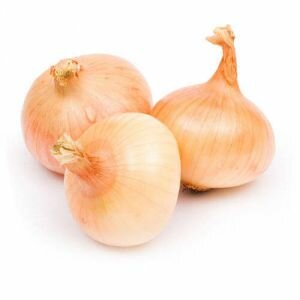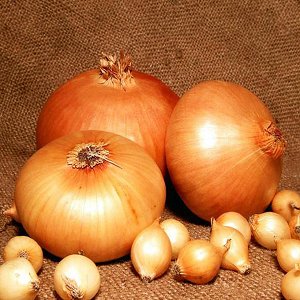High-yielding and cold-tolerant onion variety Stuttgarter Riesen
Stuttgarter Riesen is a proven onion variety that has delighted amateur summer residents and professional farmers for about 25 years. It ripens quickly, is easy to care for, high-yielding and versatile in use.
The content of the article
Description of the variety
Stuttgarter Riesen forms large, medium-sharp onions. Vegetables are suitable for fresh consumption, salads, drying, freezing and preservation.
Origin and development
Onion Stuttgarter Riesen was bred by breeders of the German company "Replacement Mauser Quedlinburg". In 1995 it was included in the State Register of Russia.
Composition and useful properties
Every 100 g of onions contains:
- dry matter - 14.9-15.2%;
- sugar - 7.0-7.2%;
- vitamin C - 10.6-11.7 mg;
- protein - 1.6%.
Due to the high content of ascorbic acid, the vegetable is especially useful for colds, as it effectively fights microbes. Onions have anti-inflammatory, tonic, expectorant and anthelmintic properties. Strengthens the secretory activity of the stomach, reduces pressure.
The vegetable contains vitamins A, E, group B, potassium, magnesium, calcium, phosphorus and a number of other substances.
Ripening period and yield
Early variety: when planting seedlings, the crop is harvested after 66-73 days, when using seeds - after 3.5 months.
With minimal maintenance, the marketable yield is 3.5–5 kg per 1 m2. Compliance with all requirements allows you to collect 5–8 kg of vegetables from the same area.
Disease and pest resistance
The Stuttgarter onion variety is resistant:
- to powdery mildew;
- fusarium;
- alternaria;
- onion fly;
- root mite.
The culture is susceptible to downy mildew, prone to neck rot.
Specifications
The bulbs are rounded, slightly flattened at the top and bottom, covered with a brown-golden husk. The average weight is 50–94 g, but there are also specimens up to 200 g.
Reference! Vegetables reach their maximum size when planting winter onion sets Stuttgarter.
The pulp is white, has a pleasant, moderately pungent taste and characteristic odor.
For which regions is it suitable
The variety is recommended for cultivation in the Central, Volgo-Vyatka, Middle Volga and East Siberian regions of Russia. It adapts well to various climatic conditions and is successfully cultivated in all regions of the country.
Main advantages and disadvantages
Variety advantages:
- consistently high yield;

- unpretentious care;
- early maturation;
- universal use of vegetables;
- good keeping quality;
- resistance to shooting and most diseases.
Disadvantages:
- the risk of developing peronosporosis and cervical rot during rainy summer;
- inconvenience when cleaning and cutting the bulbs due to their flattened shape.
Differences from other varieties
Comparison of Stuttgarter onions with other varieties and hybrids is presented in the table:
| Variety | Productivity, c / ha | Bulb shape | Taste | Bulb weight, g |
| Stuttgarter Riesen | 101–351 | Rounded, slightly flattened at the top and bottom | Medium sharp | 50–94 |
| Hilton F1 | 188–242 | Ovoid | Semi-sharp | 60–150 |
| Champion F1 | 254–420 | Rounded | Semi-sharp | 90–130 |
| Turbo | 245–337 | Rounded | Semi-sharp | 125–200 |
Features of planting and growing
Stuttgarter Riesen is cultivated from seeds or seedlings. Both methods have their advantages and some differences in fit.
Training
First of all, they choose high-quality planting material. There should be no damage, mold or rot on the seed. The coarse fraction is more suitable for spring planting, the small one for winter planting.
Seeds or sets are soaked for a day in water with salt and potassium permanganate to disinfect and protect plants from diseases and pests.
Reference! To improve germination, growth stimulants are added to the water: "Epin" or "Kornevin".
The plot has been prepared since autumn. They dig up the soil, apply organic fertilizers (rotted manure or humus), dolomite flour or ash, if the soil is too acidic. When these requirements are fulfilled, in the future, the land is only re-dug up and the beds are formed.
Ground requirements
This variety grows well on any soil, the main condition is that they should not be acidic. The maximum yield is obtained when onions are cultivated in light fertile soil with good moisture permeability and aeration. The best option is black soil or loam.
Predecessors
To get a high-quality harvest and minimize the risk of disease and pest attacks, it is important to follow the rules of crop rotation. Onions are planted after tomatoes, cucumbers, cabbage and legumes. Bad predecessors are carrots and herbs.
Timing, scheme and landing rules
Seeds are planted in spring, in mid-April, or in autumn, before frost.
Landing scheme:
- Prepare the beds at a distance of 20–30 cm from each other.
- Make shallow grooves in them and plant seeds every 1–1.5 cm, deepening them by about 2 cm.
- Slightly compact the soil, mulch it so that a soil crust does not form.
When 2 leaves are formed on the shoots, the seedlings are thinned so that the distance between them is at least 2 cm.After the appearance of 4 sheets, the thinning is repeated, maintaining intervals of 5-6 cm.
Sevok is planted in spring, when the soil warms up to + 10 ... + 12 ° C, and before winter. In the latter case, the risk of shooting increases, but it is minimized by choosing the smallest bulbs for planting.
Scheme for seeding:
- In prepared beds, make furrows 5 cm deep.
- Place the bulbs in them, deepening a maximum of 4 cm from the bottom and maintaining a distance of about 10 cm between them.
- Sprinkle with earth.
- Insulate the beds if the onions are planted before winter.
To obtain feathers, a set is used that did not fit for the main planting due to the presence of damage. Lay it out tightly, do not sprinkle it with earth, cover it with a film on top. Such plants especially need watering, top dressing with urea (20 g per 10 l of water).
Growing features
For a bow, choose a well-lit place where there are no drafts and gusty winds.
One of the main conditions for obtaining a high-quality harvest is compliance with the rules of crop rotation. The culture is not planted in the same place for at least 3 years.
If the soil is too heavy, sand, sawdust or sunflower husks are added to it.
The nuances of care
The Stuttgarter Riesen variety is not picky about care, but high yields are achieved while meeting the minimum requirements for watering, fertilizing, weeding and loosening the soil.
Watering mode
The regularity of humidification depends on climatic and weather conditions. Make sure that the top soil layer does not dry out.
Plantings are abundantly watered at the beginning of the growing season, the frequency of irrigation is gradually reduced and 3 weeks before harvesting is stopped altogether.
Loosening the soil and weeding
The soil in the aisles is weeded as the weed grows, which takes nutrients from the soil and depletes it, preventing the onions from growing and developing.
The soil is loosened 2-3 times a week to a depth of 3 cm: this improves the access of moisture and oxygen to the plant roots.
Top dressing
Fertilize the culture 3 times per season:
- 3.5 weeks after planting, organic fertilizers are applied (bird droppings or manure diluted in water at the rate of 8-10 liters per 1 m2);
- after 15–20 days, add organic matter with mineral phosphorus-containing dressings;
- at the end of June, nitrogen-containing compounds are used, in particular ammonium nitrate.
Disease and pest control
The variety is resistant to a number of characteristic onion diseases and pests, but is affected by onion fly and rot.
To prevent the development of diseases and pest attacks, it is important:
- disinfect planting material before planting;
- follow the rules of crop rotation;
- loosen and weed the soil in a timely manner;
- monitor the regularity of watering and fertilizing.
When signs of disease, insects appear, plants are treated with fungicides and insecticides.
Harvesting and storage

Drying and yellowing of leaves drying of the neck. It is important to harvest the crop in a timely manner: if it is overexposed in the ground, it will begin to germinate or rot again after the first rain.
How and when to collect
Vegetables are harvested in the second half of summer, on a dry sunny day, carefully digging out the bulbs from the beds.
Storage features and keeping quality of the variety
The bulbs are cleaned from the ground, laid out to dry in the beds or in a dry, well-ventilated room if it rains.
After drying, the vegetables are examined and sorted, removing damaged specimens, roots and leaves. Healthy and whole bulbs are placed in wooden boxes with sand and ventilation holes, and stored in a dark, cool room with moderate humidity.
If these rules are observed, the onion retains its taste and presentation until spring.
Growing difficulties
The cultivation of this variety is fraught with some problems:
- rotting of an unripe crop when planting onions in lowlands, excessive watering or frequent rains;
- illness when planting non-disinfected material;
- low yield and a large number of spoiled bulbs if the rules are not followed crop rotation.
Tips from experienced gardeners
Recommendations of experienced vegetable growers:
- so that the bulbs are larger and ripen faster, the seedlings are planted before winter;
- carrots are grown nearby: it drives away pests from the culture;
- do not plant the variety after potatoes and near dill: onions will grow weak and often hurt.
Reviews
Gardeners like the Stuttgarter Riesen onion, as evidenced by numerous positive reviews.
Elena, Orenburg: «Stuttgarter bought onion seeds unplanned: I chose others in the store, but these were advised by the seller. I took 1 sachet for testing and for 5 years now I have been planting only them. The vegetable immediately pleasantly surprised: the yield is excellent, requires minimal maintenance, does not get sick and is almost not affected by pests. The taste is excellent, moderately spicy. "
Alexey, Penza: “Choosing what is better to plant in the garden, I settled on the Stuttgarter onion variety. I liked the characteristics and reviews about it - I decided to try it. The result pleased me: the plants did not hurt anything, they quickly gave a good harvest. "
Irina, Smolensk: "Last year I planted this variety for the first time. To be honest, I didn’t even try especially, we can say that I just threw the seeds into the ground. From time to time, she watered the crop and fed it. With such a minimum of efforts, I did not expect a big harvest, but I was surprised: there are a lot of onions, all the vegetables are large, and even they lay in the cellar all winter without spoiling. "
Conclusion
Stuttgarter Riesen is an early ripening variety that adapts well to any climate, which allows it to be grown throughout Russia. It is undemanding to care for, has a strong immunity to most diseases. It is characterized by high yield, long shelf life of bulbs.